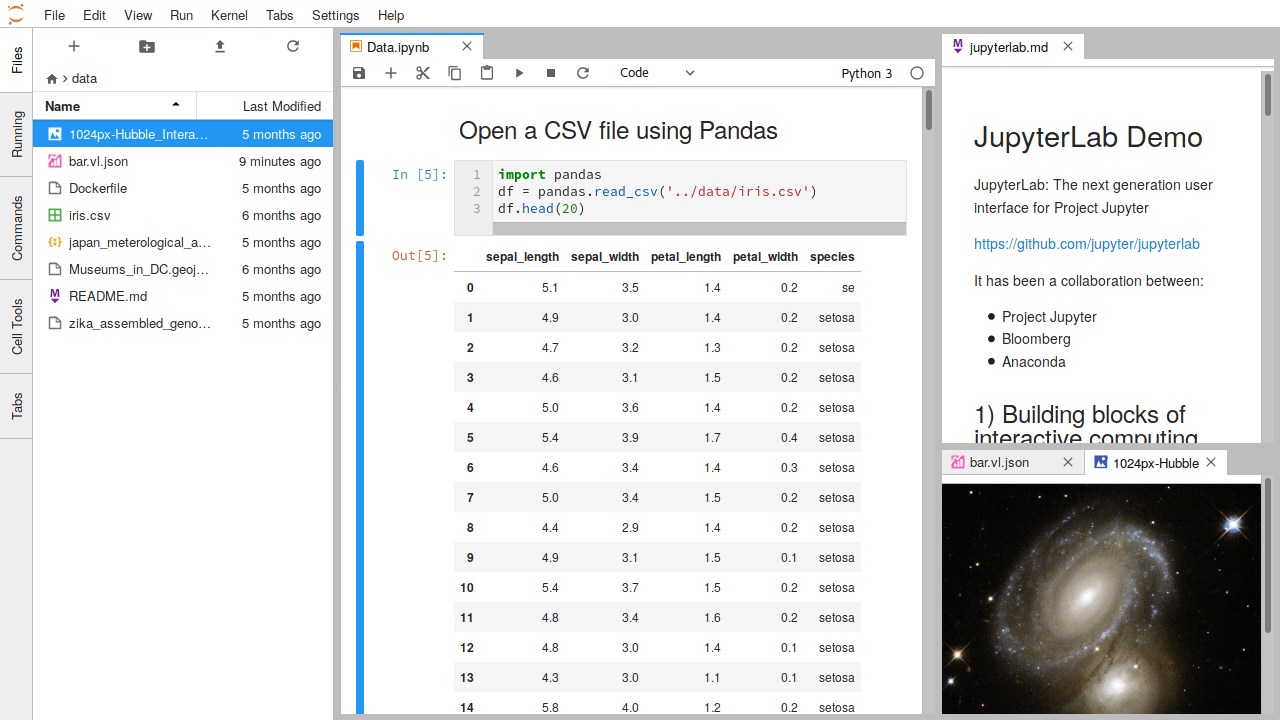

- #Jupyterlab features install
- #Jupyterlab features software
- #Jupyterlab features code
- #Jupyterlab features free
The below gif shows what this workflow might look like: data is read in from a local csv file, Python code is run in the Jupyter Notebook that transforms that csv data, and the result is visualized on a map. In this blog post, we will walk through some of the benefits of using JupyterLab in your development and data science workflows. This makes JupyterLab more of an IDE when compared to the Classic Notebook server. JupyterLab interacts with the same Jupyter Notebook format, but offers a robust file explorer, a more intuitive user interface, support for interacting with other file types, etc. While we will continue to support this Classic Notebook experience, v1.5.0 of the Python API also supports the JupyterLab experience.


Historically, this was done by running the jupyter notebook command to launch the ‘Classic Notebook’ server. The ArcGIS API for Python is designed to work extremely well with the Jupyter Notebook format. Using Python in Jupyter Notebooks has become the preferred workflow for data scientists and GIS analysts in many use cases: data cleaning and transformation, statistical modeling, data visualization, machine learning, and more. Jupyter Notebooks are web documents that let you run Python code in an interactive manner, annotate your code with maps/charts/text/equations, and share your results with others seamlessly.
#Jupyterlab features software
Jupyter’s flagship software offering is the Jupyter Notebook. There are many software packages worth exploring-but perhaps the most useful of these software offerings is Project Jupyter.
#Jupyterlab features free
Refresh JupyterLab to load the change in your browser (you may need to wait several seconds for the extension to be rebuilt).You may know that the ArcGIS API for Python provides simple and efficient tools for performing GIS analysis, visualizing your spatial data, and administrating your web GIS-but did you also know that the ArcGIS API for Python integrates smoothly with the larger open-source Python ecosystem? These non-Esri software packages are free to use, and many can provide customization options and new features that enhance your Python development experience. With the watch command running, every saved change will immediately be built locally and available in your running JupyterLab. # Watch the source directory in one terminal, automatically rebuilding when needed You can watch the source directory and run JupyterLab at the same time in different terminals to watch for changes in the extension's source and automatically rebuild the extension. # Rebuild extension Typescript source after making changes # Link your development version of the extension with JupyterLab
#Jupyterlab features install
# Clone the repo to your local environment # Change directory to the jupyterlab-vimrc directory # Install package in development mode The jlpm command is JupyterLab's pinned version of Note: You will need NodeJS to build the extension package.

The right hand side of the mapping must be defined in the default vim.js keymap.My reading of this comment and looking through the actual function leads me to believe that the restrictions are: NOTE: This will not create mappings to key maps that aren't present in the default key map. The comment for the noremap function in codemirror/keymap/vim.js says the following: The noremap commands are also availiable but come with several caveats: See the Examples for other premade settings files such as hjkl -> jkl Supported Commands For example you can map ii to in insert mode by adding the following to the settings: Commands are defined as arrays with the syntax: You can modify the contents of this psuedo vimrc by editing the settings using Settings > Advanced Settings Editor (Ctrl+,) and selecting the settings for vimrc. Or for jupyterlab=2 jupyter labextension install Usage (yank to + or * registers) (Now included in this extension!).Add a basic vimrc to jupyterlab + support for yanking to the system clipboard.


 0 kommentar(er)
0 kommentar(er)
